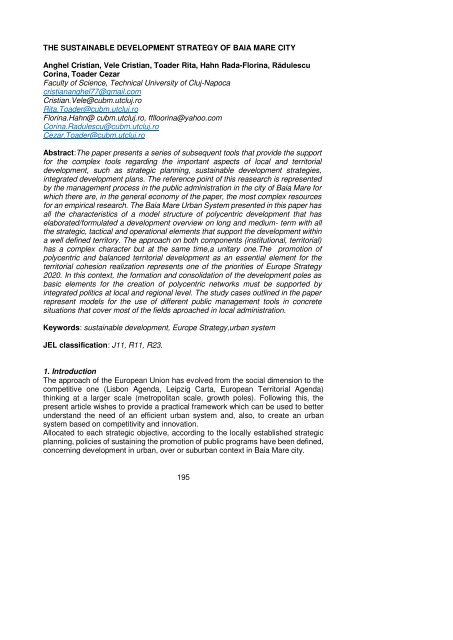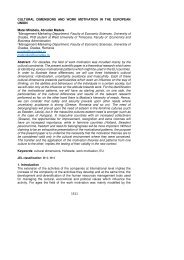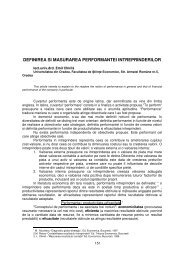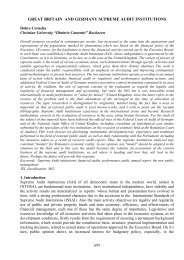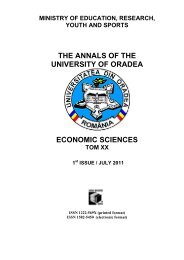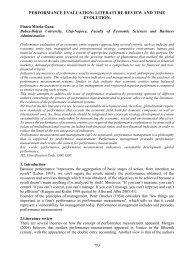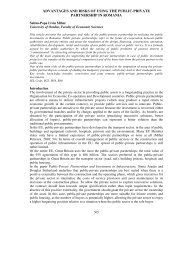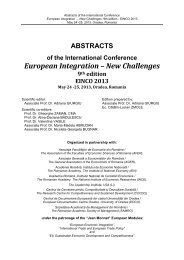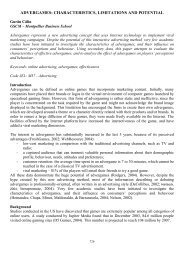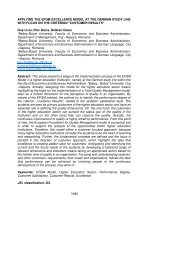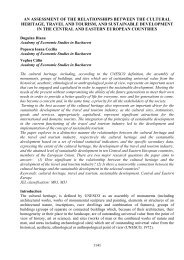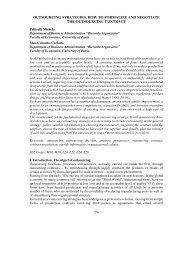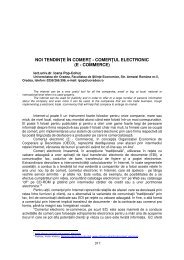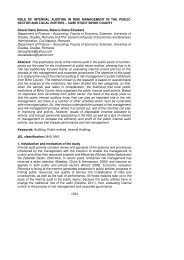195 THE SUSTAINABLE DEVELOPMENT STRATEGY OF BAIA ...
195 THE SUSTAINABLE DEVELOPMENT STRATEGY OF BAIA ...
195 THE SUSTAINABLE DEVELOPMENT STRATEGY OF BAIA ...
You also want an ePaper? Increase the reach of your titles
YUMPU automatically turns print PDFs into web optimized ePapers that Google loves.
private entrepreneurs, professional associations, education or researchinstitutions, unuions, non-governmental organizations or otherrepresentative of the civil society should be involved.Development of local networks and partnerships for the use of theparticipative mechanism correlated with an efficient information andcommunication system, which will further allow the concentration ofresources and the optimal exploitation of the local potential.Elaboration of three types of main tools meant to orient and promote arealistic and responsible vision upon the local development perspectives: alocal development strategy that sets the medium and long- term objectives;an action plan that outlines the priorities and steps to be taken on mediumand long - term for reaching the objectives set in the strategy, that will includecost assessment, identification of financial resources and how to apply forthem; a portofolio of projects considered by the entire community as prioritiesfor the sustainable development of the city or region.Completing the legal background for the integration of the strategic visionregarding spatial planning and city planning in the local and regionaldevelopment programmes. Institutional and administrative capacity-buildingin local governments in order to elaborate the strategic developmentdocuments for each locality (Local Agenda 21, sustainable developmentstrategy, integrated plans, portofolio of projects).Setting up a clear calendar for the preparation, elaboration and correlationof the strategic documents, of the mechanisms and related tools, necessaryto apply for European funds foreseen for 2014- 2020, in order to be able toreach the objectives set by the European Strategy 2020 and by the nationalprogrammes (National Reference Programme, National Development Plan,Operational Programmes).The case studies presented in the paper may represent models of good practice forany city hall in Romania as regards the increase of institutional and administrativecapacity at the level of local authorities and civil societies, the management ofpolycentric territorial-administrative developmentFor the implementation of politicise related to the integrated polycentric developmentnetwork, instruments specific to the territorial spatial planning (investment programs,territorial plans, monitoring of territorial development), non-spatial (budget, finances,administrative capacity) and strategic planning (strategies of regional development,coordination mechanisms, politics substantivise, strategic planning) are used.The promotion of polycentric and balanced territorial development as an essentialelement for the territorial cohesion realization represents one of the priorities ofEurope Strategy 2020. In this context, the formation and consolidation of thedevelopment poles as basic elements for the creation of polycentric networks mustbe supported by integrated politics at local and regional level.This public institutional construction precedes and becomes an a priori conditionregarding the success of an administratively-territorial durable development process(at the level of neighbourhoods, belonging localities) as well as at territorial level ofa superior rank: microregional, county and regional.The tactic direction of the public management modernization process. In all planningdocuments of the development at national level, the collocation “The triangle ofknowledge” is used especially within the field of “Growth of EconomicCompetitiveness”. The collocation symbolically presents the importance of the199
elationship between: (1) Universities (assimilated with fundamental researchcentres, (2) Development Innovation Centres (CDI – assimilated with platforms ofapplicative research, initiators of “pilot” projects, consultancy providers or facilitatorsof technology transfer) and (3) Enterprises, in order to ensure the competitiveadvantages on long -term period of some products or services.UniversitiesThe<strong>THE</strong>ORETICALreferenceframeworkBeneficiaries:Public institutionsLocal governmentsLEGALSpecificframeworkAdvanced DevelopmentCentersFigure 1: The development process of public managementSource: Anghel, 2013The development process of public management based on the application of “Thetriangle of knowledge” presents the following advantages (Anghel, 2013; Anghel,2006): It uses the advanced research (on long- term) and the theoreticalfoundation of the modernization instruments construction of thepublic administration ensured by the “university” partner. It ensures the optimizing process and efficiency of the constructionand practical application (adaptation to the beneficiary’s specific) ofthe public management instruments, ensured by CDI specialised indifferent fields: Technology of Information and Communication,Human Resources, Public Relations, Public Politics, FinancialManagement); It represents an answer given by de practical application of thepublic management instrument that shall lead to the evolution of thetheoretical frame of public management, ensuring its continuousdevelopment and adaptation to the modifications of publicinstitutional environment from Romania; It contributes to the creation of a legislative frame adapted to realneeds, tested by the national public system and not based onprognoses or opinions of an expert type; It allows the facilitation of a legislative frame whose norms were pretestedby pilot projects and agreed on by beneficiaries.200
Basic model for strategy designStrengthsStrengths (S)OpportunitiesOpportunities(O)WeaknessesWeaknesses(W)ThreatsThreats(T)Threats(External negativefactors, )risks)ExternalenvironmentanalysisOpportunitiesand threats(OT)Opportunities(externalpositivefactors)CriticalSuccessFactorsMissionPURPOSEVisionObjectivesStrategiesStrategicoptionsInternalassessmentStrengths andweaknesses(SW)Strengths(internalpositivefactors)DistinctiveCompetenciesStrengthsStrengths(S)OpportunitiesOpportunities(O)WeaknessesWeaknesses(W)ThreatsThreats(T)Weaknesses,(External negativefactors , ext. RisksStrategies / TacticsdefensiveSocialResponsibilityEvaluation andStrategy SelectionManagerial valuesStrategies / TacticsOffensiveZero (BAU )alternative(Non-involvement,Bussiness as Usual)PessimisticalternativeRealisticalternativeOptimisticalternativeIdealisticAlternativeStrategy implementationFigure 2: Model for strategy elaborationSource: Anghel, 2013The base model used for the formulation of the strategy was used in all phases ofthe measurements, starting from a simplified model with approaches on twodirections represented by the SWOT analysis part (analytical approach), respectivelythe visionary measurements (overview, mission, strategic targets). The twoapproaches have finally generated five types of strategic alternatives (zeroalternative, pessimistic alternative, optimistic alternative, realistic and visionaryalternative)The model emphasizes the two great types of approaches (defensive and offensive)important especially in tactical phases that aim at medium- term targets.Another advantage of the model is the emphasis and picture of the distinctivecompetitiveness and competent elements as critical factors of success, respectivelythe social responsibility and managerial values as important elements within thecomplete201
Where we want to go?Vision Urban Development (2012_2020)2012_2020_2030...Strategic Level(Urban)Territorial DevelopmentThe Urban - Baia Mare Metropolitan Area (SUBM)Sustainable DevelopmentLocal Sustainable Development Strategy (LA21)Urban RegenerationIntegrated Urban Development Plan (PIDU)Impact Indicators(long term /Trends)Tactical Level /PoliticsPlans / Programs / Public Policy /sectoral developmentfor each area of sustainable development:economicsocialenvironmentculturalgood governanceOutcome Indicators(short and medium termeffects)OperationalLevelActions / Projects (Development)Delivery of Value Added(Products, services, know-how)Output Indicators(short-term effects, services, products,added value!)Input / ResourcesWhere We Are?Profile / potential urban / territorialFigure 3: Concept of Local – Territorial Integrated DevelopmentSource: Anghel, 2013A series of public management instruments are interconnected in order to realise aunitary construction that covers the entire problematical aspects of a community ata county capital city level.The Scheme of the Local-Territorial Development Concept synthetically presents:(a) The content of the stages of local-territorial development planning: Definition of urban – territorial profile based on the quantitative indicators(statistics) and the qualitative indicators of the local resource types (natural,physical, human, social and financial); Evaluation of the development potential (based on the strategic analysesSWOT/PEST of the local – territorial profile); Establishment of strategic planning elements; Definition of the development overview, an ideal image of a desirable future,shared within the community;Establishment of development targets and measures (strategies andprogrammes)From the territorial perspective of the administrative unit (subunits –neighbourhoods, or supra-units– territorial cooperation areas; microregional,counties, regional);From the sectorial field perspective of the local development integratedwithin the concept of durable development (economic, social, environment,culture, governing)202
(b) The process of local-territorial planning, definitive for the local capacityevaluation of public management. It is defined through the involvement degree (civicparticipation) of all concerned parties in all planning stages (by information,consulting, participation ), ensuring the participative character of the elaboration,public assumption and application of local-territorial development politics.(c) The levels and types of indicators of the monitoring and evaluation system ofthe implementation progress of development elements: Impact indicators (long- term effects on big groups of beneficiaries, the entirecommunity), definitive for the degree of achievement of strategic objectives; Result indicators (short- term effects on some specific target groups) thatdefine the degree of the achiement of the programmes, applied plans,respectively of the specific objectives and planned measures; Exit indicators/“output” (services and products realised as a result ofprojects’ application, services provided within the Local - Territorial ActionPlan)3. ConclusionThe sustainable development strategy of the Baia Mare city defines the generalframe in what the decision-making process in urban planning is concerned. It is acomprehensive document which defines the Urban Agenda for Baia Mare, puttingtogether visions, projects and opportunities with a particular stress on sustainableoptions. It offers solutions for development creating a sound basis for the future ofthe city as well as a frame for a better use of structural funds.In the process of drawing the sustainable development strategy of the Baia Maremunicipality there has been used for the first time in Romania the poster-plan typeof cartography, which presents the main strategic choices until 2020. It is a synopticdocument which projects the future of the community, a perspective document whichputs into the limelight both the conceptual axes of the city’s development and thezones envisaged for intervention within the following years. ( zones of urbandevelopment, zones of urban regeneration).My recommendation refers to the extrapolation of this collocation at the level of publicmanagement by the promotion and support of a development process of publicmanagement at national and local level based on the collocation named “TheTriangle of knowledge”, that emphasizes the partnership relationships that must bebuilt at the level of a community, with extended possibilities at territorial level.Thus, a useful co-operation between the fundamental actors of the community thatmust participate in formulating the development overview and the elaboration andimplementation of all fundamental documents that contribute to the increase of localcapacity of development is achieved.The development of the management capacity of local public administrationinstitutions requires the use of some modern management instruments that shalllead to an increase of the administrative capacity at local level.The case studies presented in the paper may represent models of good practice forany city hall in Romania as regards the increase of institutional and administrativecapacity at the level of local authorities and civil societies.For the implementation of politicise related to the integrated polycentric developmentnetwork, instruments specific to the territorial spatial planning (investment programs,territorial plans, monitoring of territorial development), non-spatial (budget, finances,203
administrative capacity) and strategic planning (strategies of regional development,coordination mechanisms, politics substantivise, strategic planning) are used.The promotion of polycentric and balanced territorial development as an essentialelement for the territorial cohesion realization represents one of the priorities ofEurope Strategy 2020. In this context, the formation and consolidation of thedevelopment poles as basic elements for the creation of polycentric networks mustbe supported by integrated politics at local and regional level.The Baia Mare Urban System presented in this paper has all the characteristics of amodel structure of polycentric development that has elaborated/formulated adevelopment overview on long and medium- term with all the strategic, tactical andoperational elements that support the development within a well defined territory.ReferencesAnghel, C., 2006, Dezvoltarea durabilă la nivel local şi regional din perspectivaintegrării în Uniunea Europeană, Conferinţa Internaţionala "Dezvoltarea economică,amenajarea şi atractivitatea teritoriului la nivel local şi regional", Cluj Napoca;Anghel, C., 2013, Perfecţionarea managementului public. Politici utilizate înadministraţia publică locală, SNSPA, BucureștiAnghel, C., 2006, Sisteme de management utilizate în reforma administraţiei publicelocale din municipiul Baia Mare, Conferinţa internaţională “Administraţia publică laînceputul celui de-al III-lea mileniu. Diseminarea celor mai bune practici japonezeîn România”, Bucureşti;Applen, J., D., 2002, Technical Communication, Knowledge Management, and XMLVolume 49. Number 3, Technical Communication, Arlington, VABenson, R., J., Bugnitz, T., L., et al. 2004, From business strategy to IT action: rightdecisions for a better bottom line, Hoboken, Wiley, New JerseyChoo, C., Bontis, N., 2002, The Strategic Management of Intellectual Capital andOrganizational Knowledge, Oxford University Press, OxfordBP Ware, 2007, Arhitectura Enterprise pentru Primaria Municipiului Baia MareEuropean Commission, 2007, Cohesion Policy în Support of Growth and Jobs:Community Strategic Guidelines, 2007-2013, http://ec.europa.eu/regional_policy/sources/docoffic/2007/osc/050706osc_en.pdfMatei, L., 2009, Europeanization of Administration and Civil Service, Vol. II –Support Economics Mechanisms, Editura Economică, Bucureşti204


